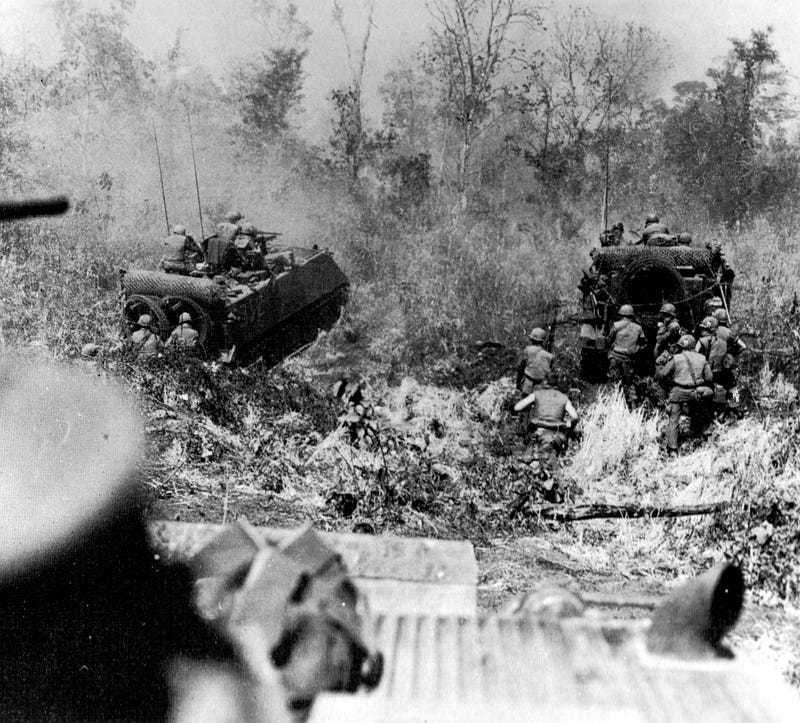Forgotten Armor: The Role of Tanks in the Vietnam War
Written on
Chapter 1: Introduction to Tanks in the Vietnam War
The Vietnam War is renowned for its dense jungles, hidden traps, and fragmented skirmishes. Unlike previous large-scale conflicts, this war lacked significant troop movements or grand battles. Instead, it was largely characterized by guerilla tactics. Consequently, main battle tanks often found themselves sidelined and serving in supportive capacities. Nevertheless, various armored vehicles were present in Vietnam, from the early armored personnel carriers to successors of the M4 Sherman. Many people are unaware of the specific tanks utilized in this conflict and whether they could effectively operate in jungle conditions.
Chapter 2: Key Tanks of the Vietnam War
The M48 Patton: A Legendary Main Battle Tank

The M48 main battle tank, named after the famous General George Patton, represents a continuation of the American tradition of honoring military leaders through tank nomenclature. It succeeded tanks named after Generals Sherman and Pershing, both of whom played significant roles in earlier conflicts. Throughout the Vietnam War, the M48 served as the primary tank for both the U.S. Army and Marine Corps.
With a notable upgrade in firepower, the M48 featured a 90mm cannon, an improvement from the 75mm cannon of the M4 Sherman. Primarily deployed as an infantry support vehicle, it excelled in this capacity during the early stages of the war. Although the U.S. forces did not engage directly with North Vietnamese tanks initially, the situation evolved as the war progressed. By the late years of the conflict, the M48 found itself facing North Vietnamese T54 tanks.
Before tank confrontations became more frequent from 1973 to 1975, the M48 enjoyed a dominant presence on the battlefield. The only serious threat to the heavily armored M48 was posed by the Sagger anti-tank guided missile, which gained prominence in Vietnam around 1972. Although the M48's effectiveness diminished as these missiles became more widespread, by that time, U.S. involvement in the war was largely reduced, leaving the remaining tanks in the hands of the South Vietnamese forces.
Despite hundreds of M48s being sent to Vietnam, only a handful were lost in intense combat, with most losses attributed to operational challenges in the harsh environment.
This video, "Vietnam: When Tank Combat Failed Against Guerilla Warfare | Greatest Tank Battles | War Stories," explores the challenges tanks faced in this unique combat environment.
The M67 Zippo: The Last Flamethrower Tank

The M67 flamethrower tank, colloquially known as the Zippo, was a modified M48 designed specifically for engaging entrenched infantry. Its main cannon was replaced with a large flamethrower, a concept inspired by similar tanks used during World War II. Deployed primarily in "mop-up" operations, the Zippo was intended to instill fear and flush out concealed opponents.
U.S. forces often faced frustration in Vietnam due to the enemy's elusive nature. Intelligence reports frequently indicated Viet Cong presence in villages, yet soldiers would find these areas either deserted or filled with civilians. Tanks like the M67 aimed to address these challenges, though its operational success was limited. Only 100 units were produced compared to over 12,000 M48s, and the Zippo was retired in 1974 without a direct replacement, marking it as the last flamethrower tank in U.S. service.
The M113 APC: A Versatile Workhorse

The M113 Armored Personnel Carrier (APC) was a crucial component of Vietnam's warfare strategy. For the first time, a majority of infantry were transported into battle using mechanized APCs instead of traditional methods like trains or unarmored trucks. The M113, equipped with a .50 caliber Browning machine gun and lightly armored, was also adapted in some variants to carry mobile mortar platforms for indirect fire support.
Thousands of M113s were produced and utilized by the U.S., South Vietnam, and Australia throughout the conflict. They served various roles, including search-and-destroy missions and troop transportation. Despite being better armored than previous vehicle options, the M113 still suffered heavy losses, with South Vietnam losing 1,400 units in 1975 alone.
The M113 laid the groundwork for modern APCs like the Bradley and BMP, and its deployment in Vietnam represented a significant evolution in infantry mobility on the battlefield. Over 80,000 M113s have been manufactured, and they continue to be utilized worldwide, showcasing their enduring legacy.
Chapter 3: Conclusion
Tanks did not dominate the Vietnam War in the same way they did in World War II; the conflict was primarily a contest of infantry tactics. As a result, many remain unaware of the tanks that operated in Vietnam. Although they were not the central focus, these armored vehicles still played a significant role, especially during the later stages when North and South Vietnam clashed in decisive battles.
